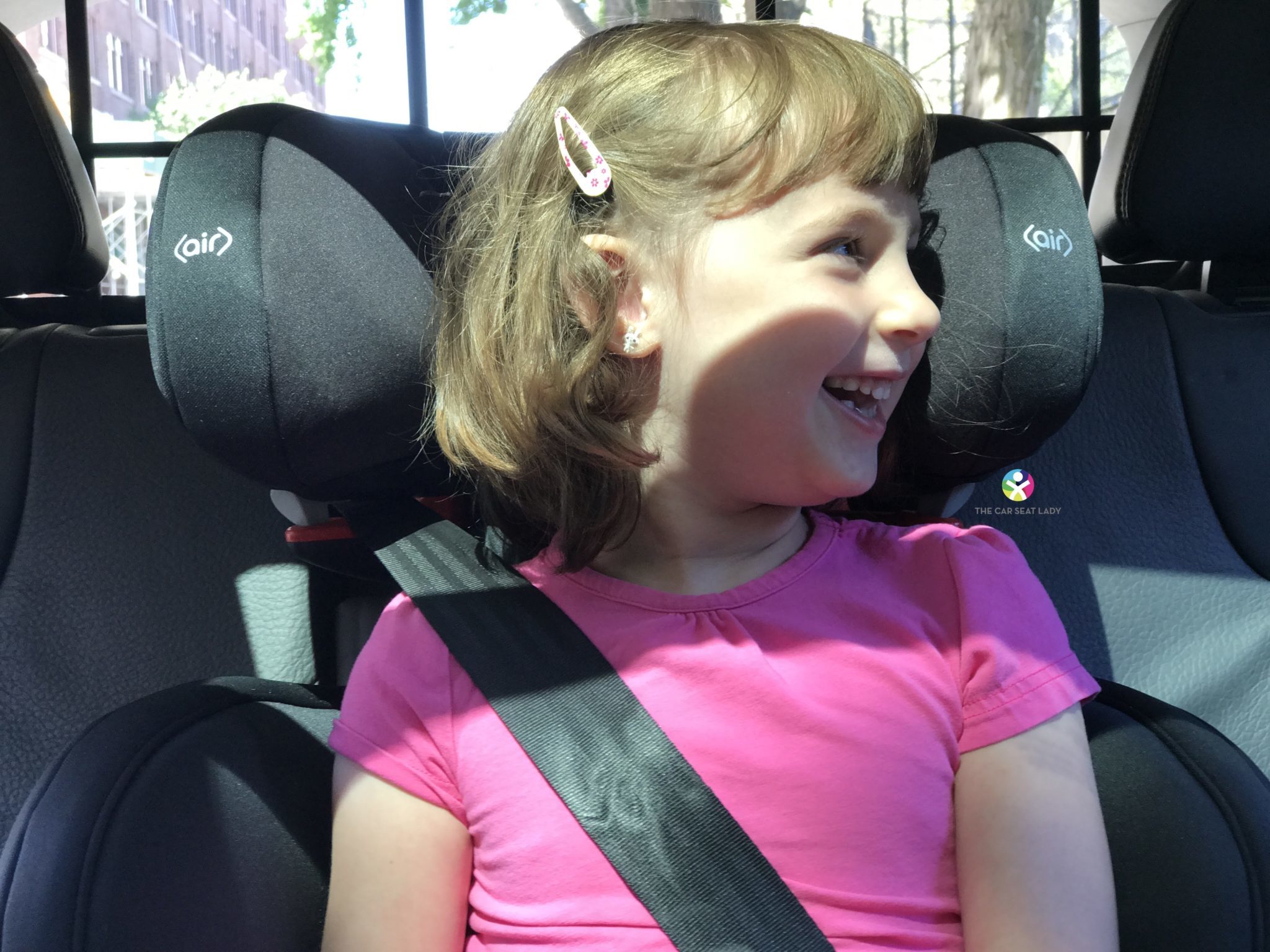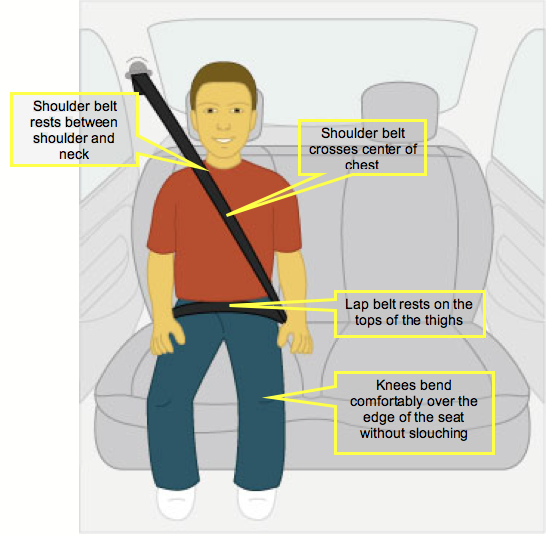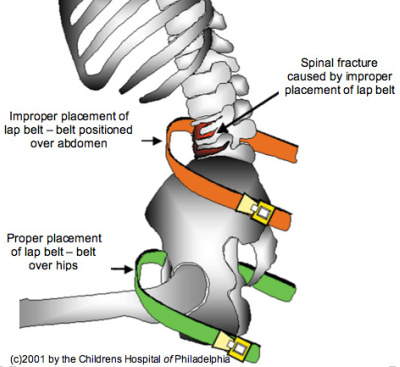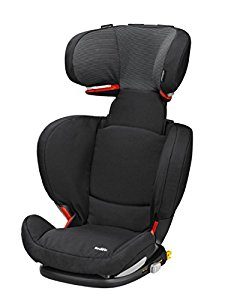
To save your child’s life! Studies indicate that a child between ages 4 and 8 riding in a booster is 59% less likely to be injured in a crash than a 4 to 8 year old wearing a safety belt alone.
Quick explanation: Cars and seat belts were designed for adults, not kids. When kids don’t use a booster they get uncomfortable (for example the seat belt gets in their face) and in attempt to get comfy they usually move into dangerous positions where they can be injured or killed in a crash. Boosters fix these problems by making the seat belt fit kids comfortably, resulting in happy children who can remain in a safe position for the car ride.
For info on when and how to use a booster, go to our Booster Basics page. Read on for an in-depth discussion of how and why boosters work.
The (very) long version of how and why boosters work: Boosters improve how the vehicle seat belt fits a child. Vehicle seat belts were designed for adults, not children, so the booster simply adjusts the child so that the seat belt fits in the intended way.
To understand why seat belts by themselves (without boosters) don’t work well for kids, we first have to understand what seat belts do and why we use them.
The seat belt has two purposes:
In order to accomplish these goals, the seat belt needs to rest on the strong bones of the body – the collar bone (clavicle), chest bone (sternum), and hip bones (pelvis). Softer parts of the body – such as the belly (abdomen) – are not strong enough to withstand the extreme forces in a crash and may be injured by the seat belt.

In order for the seat belt to work–to prevent you from being ejected and to distribute the crash forces–it needs to fit like it fits the man in this picture. Unfortunately, seat belts don’t fit kids under ages 10 to 12 this way because of three main problems, discussed below. These three factors combine together in a crash to create an extremely unsafe situation which can be corrected only by the use of a booster.
Problem 1: The shoulder belt is anchored too high
The shoulder belt is usually anchored too high up in the vehicle, despite adjustable shoulder belt anchors in many newer vehicles. Instead of crossing the center of a child’s chest and resting between the neck and the shoulder, it crosses only a small part of the chest and rests against the neck. This causes the child discomfort. Most kids respond by putting the shoulder belt behind their backs or under their arms. If the shoulder belt isn’t going across the child’s chest and shoulder, it can’t hold the child’s upper body back in a crash–allowing the possibility of severe head, neck or spinal injury.
Problem 2: The vehicle seat is too big and too deep
The vehicle seat is too deep for most kids to be able to sit comfortably without slouching, since their thigh bones (femurs) are too short. Slouching worsens the already poor belt fit by placing the lap belt further up on the abdomen and moving the shoulder belt even further off the chest and onto the neck. By creating a big gap between the child’s back and the back of the vehicle seat, slouching introduces a large amount of slack in the seat belt, which can allow a child’s head and body to move dangerously far forward in a crash.
Problem 3: The child’s body is too small and underdeveloped
A child’s pelvis (hip bones) is relatively small and cartilaginous and lacks the prominent anterior superior iliac spines of an adult’s. What does this mean? Try to feel your hip bone. What you’re touching is the anterior superior iliac spine–the part that sticks out the farthest. If you try to feel a child’s hip bones, it’s much more difficult (even on skinny kids) because the iliac spine isn’t fully formed until about age 8-10.
An adult’s iliac spine keeps the seat belt on his hips and prevents the lap belt from going into the abdomen. Unfortunately, a child’s small pelvis, lacking the fully developed iliac spine, is often unable to prevent the lap belt from riding up into the abdomen. The lap belt may start out in the proper position but moves up into the abdomen during the crash, leading to a pattern of injuries to the abdominal organs and lower spinal cord known as “seat belt syndrome. These injuries are severe and life-changing.
What does the difference in seat belt fit look like?

The correctly placed green belt rests on the hips, over a bony area of the body.
The incorrectly placed orange belt has moved up around the child’s abdomen. It’s easy to see how the spinal cord is in danger as the orange belt tightens against the soft abdomen and pushes on the spinal cord. You can also see how the soft organs inside the abdominal area would be at great risk for injury.
Better shoulder belt fit: A booster raises a child up to allow a proper shoulder belt placement — so the shoulder belt rests across the center of the chest and between the shoulder and neck. This placement is comfortable for a child (or adult) and the child is therefore much less likely to place the shoulder belt in an unsafe position, such as behind their back or under their arm. With the seat belt now in the right place, it can do its job in a crash.
Better lap belt fit: This is a complicated one—boosters make a child more comfortable in an upright position, which eliminates the child’s desire to slouch, which therefore means a better lap belt fit. Boosters do this by providing two features not found on the regular vehicle seat: support for a child’s knees, and seat belt guides.
Support for a child’s knees: Boosters are shallow (short in the leg area) and thus allow a child’s knees to bend comfortably over the edge of the seat. This is a comfortable position for a kid, and they’re likely to remain in this supported correct position throughout the car ride.
Without a booster the regular vehicle seat is too long to let a child’s knees bend, and to get comfortable on the long vehicle seat the child would likely slouch. When a child slouches, the seat belt both moves over their stomach and becomes loose, both of which can cause injury in a crash.
In a booster, the child’s back rests against the back of the vehicle seat (in a backless booster) or booster seat itself (in a high-backed booster), allowing both the shoulder belt to tighten appropriately against the child’s upper body and the lap belt to remain safely over their hips .
Seat belt guides: Boosters also include seat belt guides to prevent the vehicle seat belt from approaching the child’s abdomen. The booster will have small handles, armrests, guides or slots to position the lap portion of the seat belt low and flat across a child’s upper thighs. These guides both position the belt in the proper area and also prevent the belt from then sliding up onto the child’s abdomen.
Booster seats work in conjunction with lap and shoulder belts to restrict head movement during a crash. The farther forward the head moves, the more likely it is to be injured. These diagrams, which are courtesy of the Children’s Hospital of Philadelphia, show the difference in head movement in three different scenarios.
Lap and Shoulder Belt worn incorrectly, No Booster
In the first diagram, a child who should be using a booster seat is instead using just a lap-and-shoulder belt. However, he has put the shoulder portion of his seat belt behind his back, which means his upper body is not restrained. Look how far his head moves in a crash!

In the second diagram, a child who should be using a booster is instead using just a lap-and-shoulder belt, albeit correctly. His head still moves quite far forward during a crash.

In the third diagram, the child uses a booster correctly. His head barely moves forward and he will sustain much less serious injuries than the other two children in the above diagrams.

There are three different types of booster seats:
Which type to use depends on your vehicle, your travel needs, and your child’s needs.
These are small cushions that simply go under the child’s bottom, raising them up off the vehicle seat and placing the seat belt over the proper parts of their body. Backless boosters all have seat belt guides which keep the seat belt over the correct place on the child’s body. Sometimes armrests serve as the seat belt guides, like in this photo, while other seats use metal tubes or rings.
Benefits to backless boosters:
High Back Boosters (BPB/Combo)

Belt Positioning Boosters (BPB): Like a backless booster but with back and head support that goes up past the child’s ears. Normally used as a high-back booster, many of these models also allow you to remove the back, turning the seat into a backless booster – this option is very helpful for travel and for storage.
Combination/All-in-One: Functions either as a car seat with a 5-point harness for children up to at least 40 pounds OR a belt positioning booster for kids over 40 pounds (you simply remove the harness and use the vehicle’s safety belt to secure the child). The back is usually not removable on these models.
Benefits to high-back boosters:
Should you use a backless booster or a highback booster? Which type is right for your child?
We recommend using a high-back booster if possible, because it’s often more comfortable for kids. A comfortable child is much more likely to remain in the proper seating position while in the car. A less comfortable child will slouch, especially if sleeping, and of course will complain more! That said, we love backless boosters for playdates, taxis, travel, uber, etc., and use them constantly in these situations.
Incompatibility warning: All backless boosters require that the vehicle seat back come up at least as high as the child’s ears. This is because the top of the ears is the same height as the bottom of the skull, which needs protection in a crash. If the seat back does not come up to the top of the ears/bottom of the skull, the child is more likely to suffer whiplash injuries in a crash. If your child’s ears come up past the vehicle seat, they should use a high-back booster, where the high back of the booster itself will prevent whiplash. Note: Some high-back boosters themselves require that the seat back come up to the child’s ears, so make sure the high-back booster you have chosen for this scenario can in fact be used with a low seat back!
Is one kind of booster safer than the other?
The results of a large study suggest that the effectiveness of booster seats does not vary by the type of booster – high back or backless. Some researchers argue that this study does not reflect the variety of high back boosters currently available – with some having significant side wings that simply weren’t available when this study was being conducted.
If a high back booster is going to be safer than a backless booster, it would likely be the high back that has the deepest wings along the head and chest – which would decrease the chances of the head and chest contacting hard structures in the car. The other feature that might make one high back booster safer than another is rigid LATCH – which would prevent the lateral movement of the booster in a side impact, and thereby stand a better chance at keeping the child’s body better contained by the shell of the booster.

If you need to fit 2 car seats next to each other, or 3 car seats across one row, these boosters are the seats for you.
The best booster seats for your bigger-than-average kiddo, with safety, comfort, and longevity in mind.
